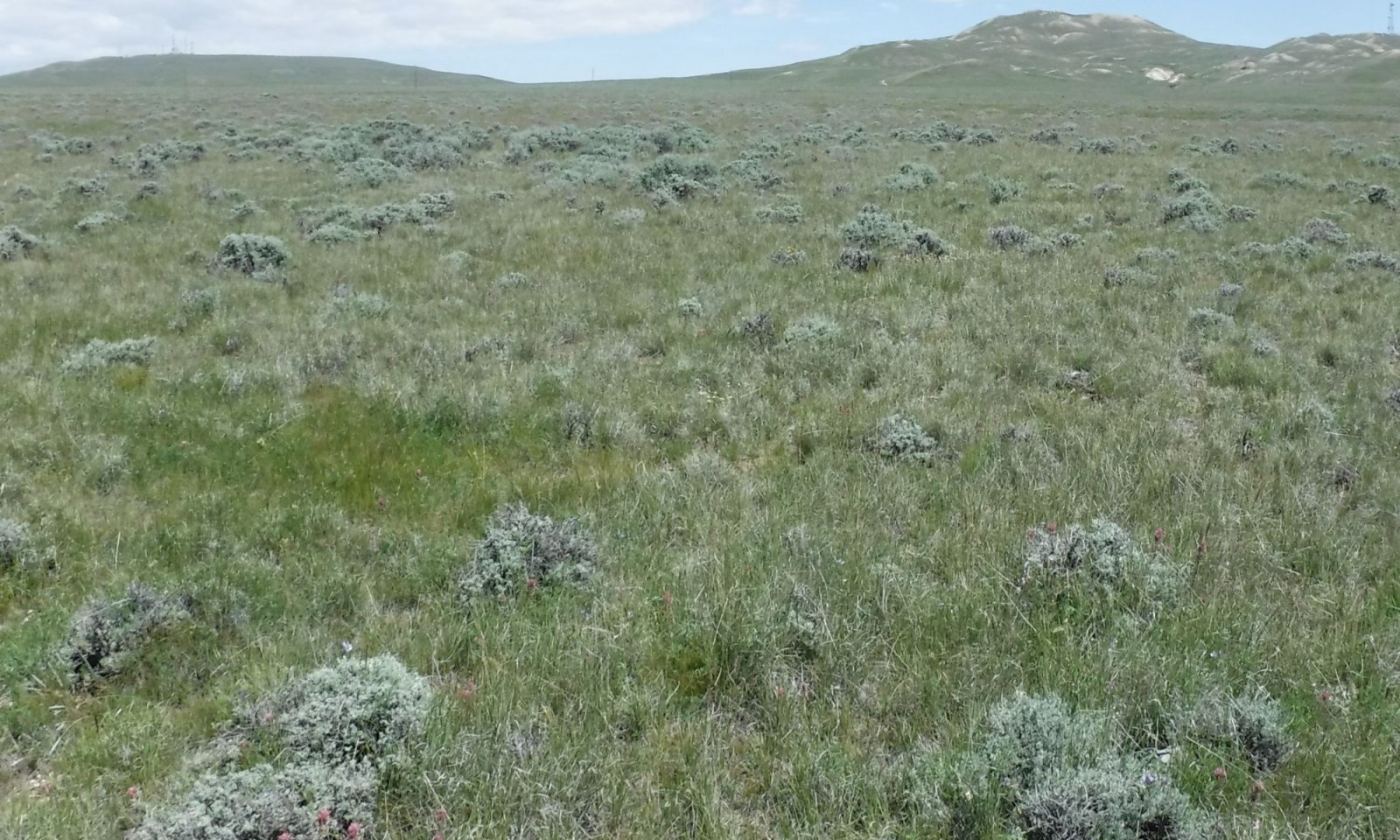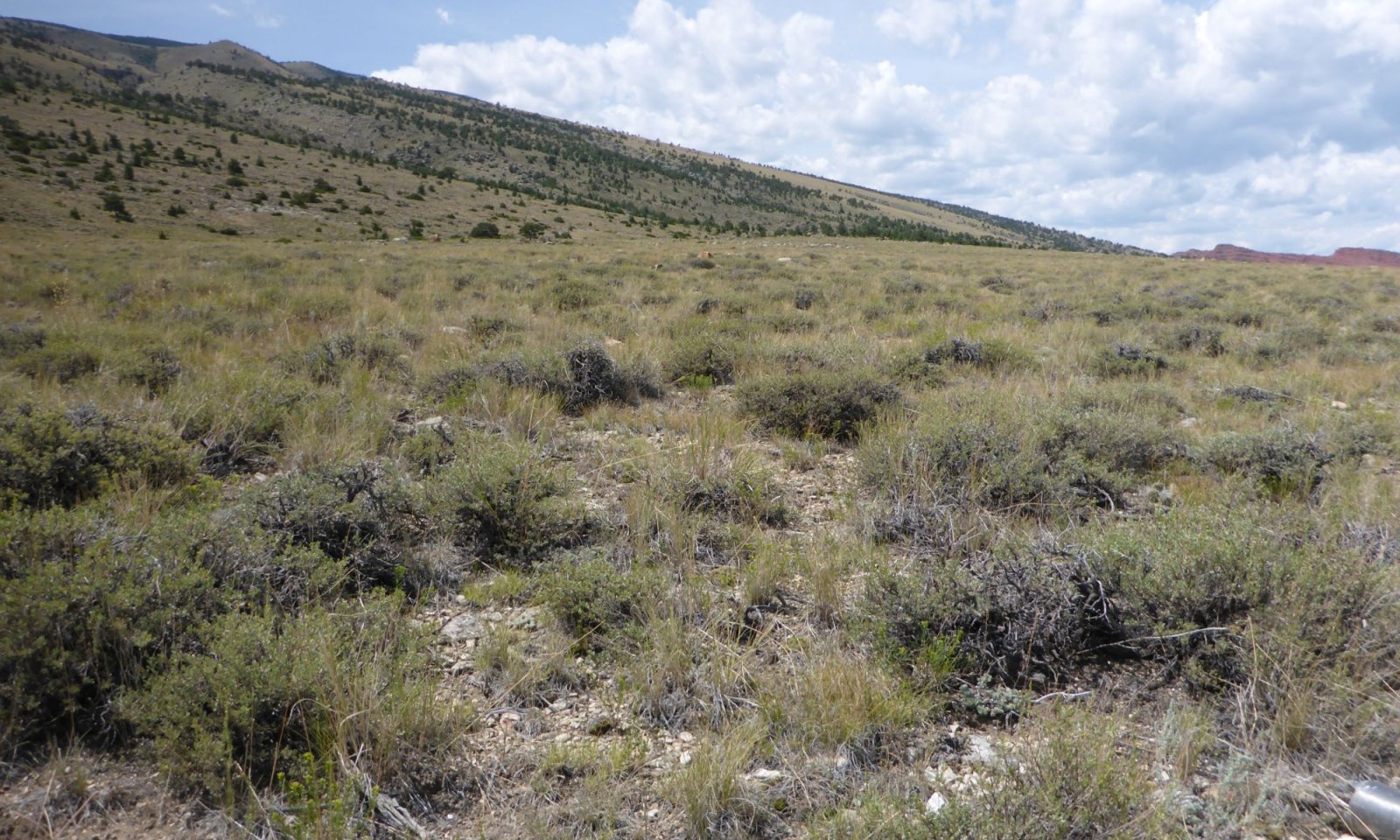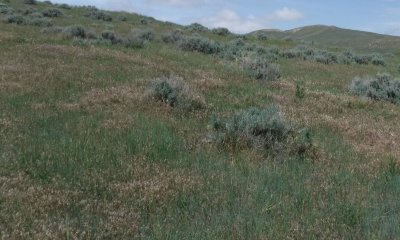
Loamy Calcareous (LyCa) Absaroka Lower Foothills
Circle-spoke model
Scenario model
Current plant community
Select a plant community
Management practices/drivers
Select a community pathway
- Pathway P4.1-4.2 More details
- Pathway P5.1-5.2 More details
- Pathway P7.1-7.2 More details
-
Transition T1-2
Frequent and severe grazing plus no fire on these droughty soils, will convert the plant community.
More details - Pathway P1.1-1.2 More details
-
Transition T1-3
Frequent and severe grazing (yearlong grazing) plus wildfire or brush control, will convert this community to a threadleaf sedge sod.
More details -
Restoration pathway R2-1
Prescribed grazing with rest and time will allow this transition. Seeding and brush control may be tools to assist recovery.
More details - Pathway P7.2-7.1 More details
- Pathway P1.2-1.1 More details
-
Transition T2-4
Frequent or Severe Grazing with wildfire or other disturbance with a seed source present transitions the community to an Invaded State.
More details -
Transition T3-4
Drought alone, or with frequent or severe grazing or other disturbances will open the canopy to invasive species.
More details -
Restoration pathway R4-5
Integrated weed control with seeding of a native mixture will assist with reclaiming this invaded community.
More details -
Transition T5-4
Frequent and severe grazing or any further disturbance with a see source will force the transition.
More details -
No pathway between the selected plant communities has been described
Target plant community
Select a plant community
State 1
Bunchgrasses/Sagebrush




Description
The Reference State, Bunchgrasses/Sagebrush State, originated under moderate grazing by large ungulates. With continued grazing management, this community has persisted on the landscape. The State is characterized by a dominance of bluebunch wheatgrass and Wyoming big sagebrush. Occurrences of black sagebrush have been found, although not prevalent on this ecological site.
Characteristics and indicators
The reference state is characterized by the dominance of Wyoming big sagebrush, at 15 percent or less composition by weight, with bluebunch wheatgrass, at 40 percent or less composition by weight. But with these two dominant species, the site holds a healthy mix of rhizomatous wheatgrass, Western and Thickspike, as well as Indian ricegrass, needle and thread, and to a minor extent sod-formers such as threadleaf sedge.
Resilience management
These communities are drought tolerant and resistant to change unless under significant stress.
Submodel
Description
If continued pressure or disturbance occurs on the vulnerable community within the reference state (State 1), it can be forced into the Sagebrush/Bare Ground State. This state name is somewhat misleading in the perception considering that bare ground may only increase slightly and in many cases there is no change or a light decrease in cover by sagebrush. Over time, drought or grazing pressures on this state will eventually drive the sagebrush/shrub canopy out or decrease the health and vigor of the plant to a non-sustainable level. The herbaceous plant production may remain only slightly decreased, but the thriving species usually occur under the canopy of Wyoming Big sagebrush or similar shrub species (rabbitbrush) and within the protection of pricklypear cactus.
Characteristics and indicators
The prominent cover of Wyoming big sagebrush and significant lichen cover or bare ground is the key indicator for this State and Community Phase. The loss of key herbaceous species is significant, although remnant populations will reside within the sagebrush crown or cactus clumps.
Resilience management
Brush management, followed by prescribed grazing, may return this plant community to a similar or near Reference Plant Community. If prescribed fire is used as a means to reduce or remove the shrubs, sufficient fine fuels will need to be present. This may require deferment from grazing prior to treatment. Post management is critical to ensure success. This can range from two or more years of rest to partial growing season deferment, depending on the condition of the understory at the time of treatment and the growing conditions following treatment. In the case of an intense wildfire that occurs when desirable plants are not completely dormant, the length of time required to reach a community within the Reference State may be increased and seeding of natives is recommended.
Submodel
State 3
Sod-former



Description
Threadleaf sedge is a sod-forming species that exist as a component of the perennial vegetation naturally (in reference communities) in the Loamy Calcareous ecological site. The general tendency of threadleaf sedge is to increase under grazing pressure, becoming dominant. The root-mat created as threadleaf sedge increases slows water infiltration, increasing runoff and reducing the hydrologic function of this community.
Characteristics and indicators
Threadleaf sedge will be the major soil cover of this community with a deteriorating component of sagebrush and cactus. As sagebrush declines, pricklypear cactus tends to increase in composition in the community.
Resilience management
Threadleaf sedge is extremely resilient and resistant to degradation once established. This creates a stable community.
Submodel
Description
Invasive plant species are a permanent concern with rangelands and management. Each year new species are discovered and will alter this section as they are. Currently within the Big Horn Basin there are several varieties of thistles, knapweeds, milkweeds, mustards and others that create a management issue for livestock and ecology. In areas where there has been a disturbance, natural or man-made, these species can gain a place in the landscape and are difficult to impossible to eradicate. Because of this it becomes a battle to maintain control with annual or prolonged management of the weed species, and preventing further shifts or changes to the native composition.
Characteristics and indicators
The presence of an invasive weed in a community warrants the transition to the Invaded State once it is at least 5 percent of the canopy cover or composition by weight in the community.
Resilience management
Treatment of many of the common invasive species is difficult and requires continual maintenance. Eradication, in many situations, has not been achieved. This leaves invaded communities open to further degradation, but resistant to improvement.
Submodel
Description
The Disturbed state could be drafted as a stand-alone box within the state and transition model diagram. No matter what state a site originally is ranked in, once the site is mechanically disturbed, or suffers a catastrophic or significant natural disaster that alters the soil properties (erosional, depositional, hydrological or chemical), the site potential is altered.
Characteristics and indicators
To consider this as an alternate ecological site would not be unreasonable. In some cases (site by site consideration), a re-correlation of a location may be the best solution. But in many cases, the site has not been altered out of the current site, but the potential has shifted enough that it is no longer truly comparable to the reference community. So a dynamic state was captured to detail the altered communities that exist on the landscape.
Resilience management
The response to management varies with the specific form of disturbance, the stage or level of restoration attempted or the age of the community post disturbance. These communities are in a state of flux and are sensitive to further disturbance.
Submodel
Mechanism
Frequent or Severe Grazing, Drought/Insect Damage, Fire/Wildfire – The Wyoming big sagebrush component of this community is the at risk species. Sagebrush will decrease under drought, and if grazing pressures persist through season or year-long patterns, becoming decadent and then dying. The sod dominated community reduces the ability for sagebrush to propagate, also leading to a recession of sagebrush. Although rare in occurrence, due to lack of fine fuels and canopy cover, fire will remove the shrub canopy as well. In some cases on the edge of the precipitation break, Rubber rabbitbrush will dominate a site as sagebrush diminishes. It is also noted that with periods of drought that have occurred in the past ten years, there is a noted decrease in the health and vigor of Blue grama and Threadleaf sedge. The dense root structure of the sod-former plants is reduced allowing other species to establish. The spring of 2014 has shown a flush of Sandberg bluegrass occupying Blue grama communities, and in some instances appear to be the dominant production for that community.
Mechanism
Frequent or Severe Grazing, Drought, Disturbances (mechancial) and Wildfire – Drought, wildfire, or other climatic stresses on the system can continue to stress the native species reducing their ability to maintain their footprint in the plant community. This continued stress or the complication with mechanical disturbances or, frequent or severe grazing or pressure from wildlife and livestock can reduce the natives to an unviable or unsustainable population and allow the invasive species to dominate the site. This is more typical in species such as knapweeds, Canada or Bull thistle, and specifically Cheatgrass (Downy brome).
Mechanism
Seeding, Brush Management, Integrated Pest Management, Prescribed grazing management – With the proper mechanical improvements and the follow-up through establishment and then maintenance, a disturbed site can be improved and managed. However, climatic limitations and soil chemistry limit the success of seeding treatments. Depending on the site location, invasive species are a risk to most sites within the Basin and create a low success potential for this process.
Mechanism
Frequent and severe grazing plus no fire on these droughty soils, will convert the plant community to the Big Sagebrush/Bare Ground Plant Community. The probability of this occurring is high. This is especially evident on areas with historically higher precipitation and the sagebrush stand is not adversely impacted by drought or heavy browsing.
Constraints to recovery
The calcic layer in these soils limits water and nutrients, making recovery difficult on this site.
Mechanism
Moderate, continuous season-long grazing will convert the plant community to the Rhizomatous/Perennial Grass/Big Sagebrush Plant Community. Prolonged drought will exacerbate this transition. The stressers reduce the bunchgrasses such as Bluebunch Wheatgrass, Needleandthread, Indian ricegrass; allowing the solitary growth and sod-formers to increase in dominance in the community.
Mechanism
Frequent and severe grazing (yearlong grazing) plus wildfire or brush control, will convert the plant community to the Blue Grama Sod Plant Community. The probability of this occurring is high, especially if the sagebrush stand has been severely affected by drought or heavy use or has been removed altogether.
Constraints to recovery
The dense root system and altered hydrology presented by threadleaf sedge limits the ability for this community to recover to Reference.
Mechanism
Prescribed Grazing with rest will allow remnant grass species to begin to recover. Time is the biggest component that is needed for this recover, with cooperative climatic conditions. Seeding of native species will assist the process with brush control may be needed to make this transition happen.
Relevant conservation practices
| Practice | External resources |
|---|---|
|
Brush Management |
|
|
Critical Area Planting |
|
|
Prescribed Grazing |
|
|
Grazing Land Mechanical Treatment |
|
|
Heavy Use Area Protection |
|
|
Upland Wildlife Habitat Management |
Mechanism
No use, No Fire, Long Term Prescribed Grazing, Frequent or Severe Grazing. In general, if a site is not maintained with the conditions of which the species are adapted under, a decline in vigor will occur and then a shift in composition will occur. Since the site is altered from reference state in soils due to plowing, mining, or other similar disturbances, the plant community will not follow the same expected shifts of a native community and this will refer back to a community more reflective of a disturbed plant composition.
Mechanism
Prescribed grazing or possibly long-term prescribed grazing, will allow recovery of this plant community to the Reference community. The probability of this occurring is high especially if rotational grazing along with short deferred grazing is implemented as part of prescribed method of use. In addition, the removal of fire suppression will allow a somewhat natural fire regime to reoccur to more easily transition between this plant community and the reference community. A prescribed fire treatment can be useful to hasten this transition, if desired and if invasive species risk is low. Other brush management techniques, such as mechanical or chemical are alternatives.
Mechanism
Frequent or Severe Grazing, Wildfire, Disturbance - The chance of wildfire is reduced with the loss of the fuels from sagebrush to help carry across large areas, however, in favorable production years areas can produce enough fine fuels to carry a wildfire which in turn opens the canopy and provides a niche for annual invaders such as Cheatgrass and knapweeds to take hold. If the seed source is available, fire is a well-known avenue to provide the conditions for annuals to flourish, as well as general disturbance whether from herbivores or man-induced.
Constraints to recovery
Once the seed source gains a place in the community, it is extremely difficult to manage and may not be feasible or possible to completely remove the invaders.
Mechanism
Drought, Frequent or severe grazing, Disturbance – Drought as the only factor or drought with grazing intensity together can work to weaken the native species on this site to allow invasive species to establish. Threadleaf sedge has been seen to die back or die out with prolonged drought opening the canopy and the community’s vulnerability to invasive species. Disturbance by mechancial means or human activities that break the root masses or disturb the soil surface open this closed community to potential invasive species, especially when there is a readily available seed source for those invasive species.
Constraints to recovery
The lack of tools to eradicate invasive species is the major constraint to recovery of this community.
Mechanism
Integrated Pest Management, with Seeding the site to a native mixture - Success is not known to have occurred, and is rated to be low and highly variable for the rate of control of most species. Cheatgrass and knapweeds are two of the most invasive species for many of these sites but there are many others, for example, Halogeton, that can dominate these sites. It is a consensus that the site can be brought to an at-risk community within the reference state, but that it is not possible to reach the reference community condition once annuals have established on a site.
Relevant conservation practices
| Practice | External resources |
|---|---|
|
Critical Area Planting |
|
|
Prescribed Grazing |
|
|
Grazing Land Mechanical Treatment |
|
|
Range Planting |
|
|
Integrated Pest Management (IPM) |
|
|
Upland Wildlife Habitat Management |
Mechanism
Frequent or Severe Grazing, Disturbance with a seed Source, or Drought - Any stressor that is applied with the inherent seed source puts this state at risk to transitioning into an Annual Grass or Invaded State.
Constraints to recovery
The lack of control tools to eradicate cheatgrass and other invasive species, limit the ability for recovery of this community.
Model keys
Briefcase
Add ecological sites and Major Land Resource Areas to your briefcase by clicking on the briefcase (![]() ) icon wherever it occurs. Drag and drop items to reorder. Cookies are used to store briefcase items between browsing sessions. Because of this, the number of items that can be added to your briefcase is limited, and briefcase items added on one device and browser cannot be accessed from another device or browser. Users who do not wish to place cookies on their devices should not use the briefcase tool. Briefcase cookies serve no other purpose than described here and are deleted whenever browsing history is cleared.
) icon wherever it occurs. Drag and drop items to reorder. Cookies are used to store briefcase items between browsing sessions. Because of this, the number of items that can be added to your briefcase is limited, and briefcase items added on one device and browser cannot be accessed from another device or browser. Users who do not wish to place cookies on their devices should not use the briefcase tool. Briefcase cookies serve no other purpose than described here and are deleted whenever browsing history is cleared.
Ecological sites
Major Land Resource Areas
The Ecosystem Dynamics Interpretive Tool is an information system framework developed by the USDA-ARS Jornada Experimental Range, USDA Natural Resources Conservation Service, and New Mexico State University.



